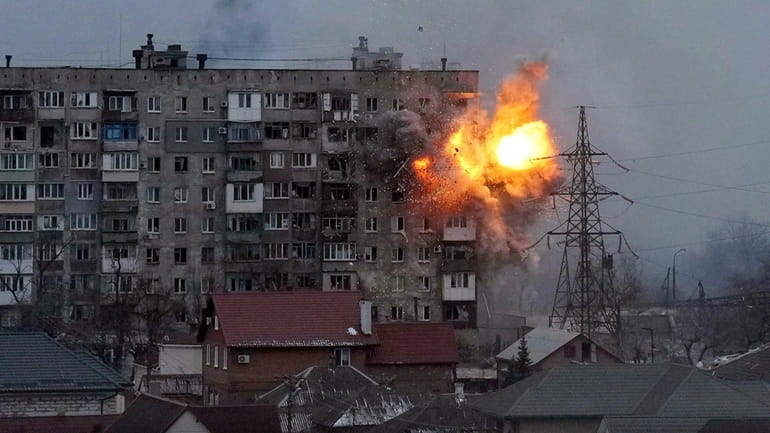Mariupol film exposes savagery of war, shows why Ukraine should make no concessions to Russia

A Russian army tank fires on an apartment building in Mariupol, Ukraine, in March 2022, in an image that is part of the documentary "20 Days in Mariupol". Credit: AP/Evgeniy Maloletka
While the debate about U.S. assistance to Ukraine continues to be mired in domestic political squabbling, a searing film chronicling the early days of Russia’s assault on Ukraine, “20 Days in Mariupol,” has just received an Academy Award nomination for best documentary as well as the prestigious Dupont-Columbia journalism award.
Made by video journalist Mstyslav Chernov and produced by The Associated Press and the PBS program “Frontline,” the film — available on streaming platforms — tells a tragic tale that needs to be remembered. It should also serve as a powerful reminder of why Ukraine must not be forced into territorial concessions to Russia and why Vladimir Putin must not be allowed to keep ill-gotten gains from his war of aggression.
Mariupol, a port city in eastern Ukraine’s Donetsk region just 35 miles from the Russian border, was one of the first targets of Russian assault in the February 2022 invasion that nears its second anniversary. Chernov and his team went to Mariupol just before the invasion and stayed there two weeks after the rest of the media had left, recording what they saw — from the first Russian tanks moving down the streets to people huddling in bomb shelters, buildings reduced to rubble, desperate people looking for food or trying to escape the besieged city, and men dumping dozens of black body bags into a mass grave.
What the documentary shows is harrowing in a way news reports don’t convey. “20 Days in Mariupol” shows a lot of raw footage shot for The Associated Press alongside TV reports using edited and sanitized clips from that footage; the contrast is startling. It’s not just the gore, it’s the emotion: Where a TV report shows a man hunched in grief over the body of his teenage son, the raw footage shows him wailing as he kisses the dead boy’s forehead.
The film also exposes the lie of Russia’s claims that it is fighting to liberate the ethnic Russian population from oppression by Ukrainian nationalists. Virtually every local in “20 Days in Mariupol” speaks Russian (like the rest of the region, the city has a large population of Russian speakers). Their message is clear: They don’t want Russia here.
Mariupol was surrendered to the Russian army on May 20, 2022. The civilian death toll is estimated at 21,000 to 75,000.
Kremlin propaganda has tried to turn Mariupol into something of a showcase for a new “Russian” Eastern Ukraine. Last month, a Russia-linked group almost held a conference and exhibition titled “Mariupol: Rebirth after the War” in the Italian city of Modena — the moral equivalent of a rapist bragging about the medical care he has provided for the battered victim. Luckily, the authorities came to their senses and withdrew the permit.
As The Associated Press has documented, Mariupol’s “rebirth” under Russian occupation includes not only scrubbing the city of Ukrainian identity and culture but bulldozing heavily damaged buildings with, most likely, dead bodies inside. It also includes a replacement of the population. Of the half-million people who lived here before the war, fewer than a third remain. The imports include Russian construction workers, military and administrative personnel, and Russians happy to buy cheap real estate in an occupied city.
The costs of continuing war are high. But the moral costs of allowing an aggressor country to keep a ravaged city as its trophy must be reckoned with as well. “20 Days in Mariupol” is a call for such a reckoning.
n OPINIONS EXPRESSED BY CATHY YOUNG, a writer for The Bulwark, are her own.
Opinions expressed by Cathy Young, a writer for The Bulwark, are her own.

